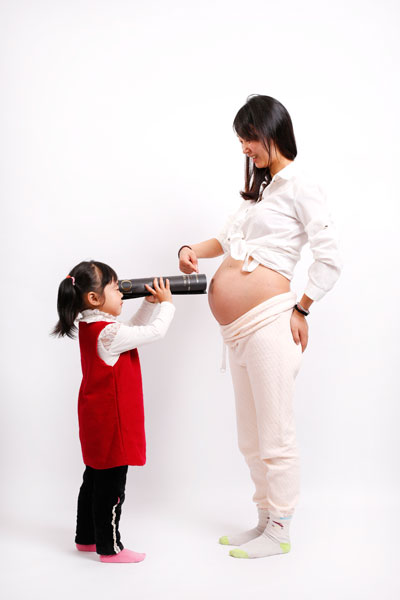

New rules allow couples in China to have an extra baby if one partner is an only child. However, uterine damage as a result of a cesarean delivery, a common procedure in the country, poses a threat to further pregnancies. Liao Zhengyan / for China Daily
Changes to the rules governing family planning prompted hundreds of thousands of couples to register to have a second child, but a former reliance on cesarean deliveries is causing misery for many.
Fang Yan should have had a baby in early July. It would have been the family's second child, conceived after Fang and her husband joined the 700,000 couples that registered to have another child following the 2014 announcement of amendments to China's family planning policy.
The new rules allow couples to have a second baby if one partner, like Fang's husband, is an only child. The couple, both 38, had their first child, a boy, three years ago. In October, they were overjoyed to learn that Fang was pregnant again.
However, bad news quickly followed good. Fang was diagnosed with a cesarean-scar pregnancy - a rare occurrence. The fertilized egg had become embedded in the scar from the cesarean she had at age 35. The situation could have been life-threatening, so Fang terminated the pregnancy.
"It's difficult to describe the sadness of losing this baby. My son was born via cesarean section because I was scared of the pain of a natural, first delivery, and also worried about potential problems I might encounter because of my age," she said in a choked voice. "Three years ago, we didn't plan to have another child because of the family planning policy, and we never imagined that a cesarean scar might be a bomb that would kill my second child."
Fang is not alone. In early January, He Rui, 31, who is also eligible to have a second child, was told that the scar from a cesarean she had four years ago was too thin and there was a potential risk of uterine rupture during pregnancy.
The 31-year-old had her first child, a girl, via a cesarean delivery because she and her husband wanted the baby to be born before Sept 1, and start school a year earlier. "We really wanted to have another child so our son won't grow up alone. The new policy could have made our dream come true. It's hard to accept that our dream has been destroyed by this scar," said He, from Kunming, the capital of the southwestern province of Yunnan.
Cesarean section accounts for about 47 percent of all births in China. That's the highest rate for the procedure worldwide - the recommended rate is less than 15 percent - according to a 2010 report by the World Health Organization. Statistics released at a national seminar in April indicated that nearly 25 percent of cesareans performed in China have no medical rationale.
Trial of labor
About 40 percent of women who wanted to have a second child in cities such as Beijing, Shanghai and Shenzhen in Guangdong province, had their first child via C-section, according to a report by Xinhua News Agency in July. The report quoted a doctor at a hospital in Anhui province who said she treated one or two women every week who had to be dissuaded from a second pregnancy because of problems caused by a previous cesarean.
In July, Lang Jinghe, director of the obstetrics department at Peking Union Medical College Hospital, told a medical conference that the problem of China's high C-section rate will be clearly revealed by the new policy.
Attempting a vaginal birth after a cesarean section is known as Trial of Labor after Cesarean, or TOLAC. According to the American College of Obstetricians and Gynecologists, a uterine rupture is the most serious risk associated with the procedure.
The risk of rupture of the uterus after a previous low-transverse C-section, a horizontal incision at the lower end of the uterus, is about 1 percent, whereas the risk after a "classic" C-section with a T-shaped incision, a method once widely used in China, is 8 to 10 percent, according to ACOG.
"The risk of uterine rupture for women who get pregnant after a C-section is not very high, but a rupture would be very dangerous for both mother and baby," said Zhang Lihua, a retired obstetrician who worked at the Beijing Obstetrics and Gynecology Hospital for 35 years.
"The placenta is like the root of a tree. As the baby grows, the placenta also needs to grow to seek more nutrition. The scar left by a previous cesarean delivery is not the best place to obtain sufficient nutrition, and the growth of the placenta will lead to a life-threatening condition," she said.
Copyright ©1999-2018
Chinanews.com. All rights reserved.
Reproduction in whole or in part without permission is prohibited.